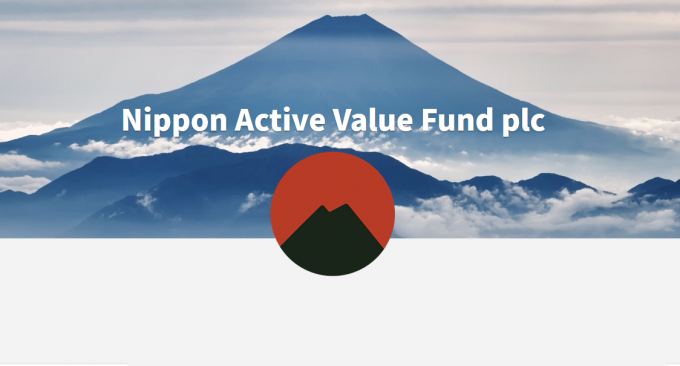Nippon Active Value Fund has published results for the year from 1 January 2022 to 31 December 2022.
At the end of the year, the NAV 140.5p, +3.5% over the year and the MSCI Japan Small Cap Index returned -1.6% (both in sterling terms). The closing share price on 31 December 2022 was 117.5p, reflecting a discount of 16.4% to NAV. The average discount to NAV over the Year was 8.9% and the shares traded in wide range from a premium of 5.2% to a discount of 16.7% to NAV. Since the end of the year the discount has narrowed and stood at 6.7% as at 3rd April 2023.
There’s a dividend of 3.2p, up from 1.95p for the prior year. The board does not set a target for the dividend, but will pay out substantially all of the distributable income for any particular period by way of dividend.
Cash balances were running high at the year end – £31.7m at end December and 30.4% of NAV now. There is also an unused £30m borrowing facility.
The statement says that the number of activist funds operating in Japan has risen from 17 in 2017 to 65 in May 2022. While US and European funds are still the largest group, over that period domestic activist funds have increased from fewer than 5 to 18. The number of shareholder proposals presented to AGMs in 2022 rose by 80% to 293 and the number of companies subject to proposals rose by 60%, to 77. About half of the proposals are related to balance sheet efficiency such as share buybacks or dividend increases. More of them were supported by over 20% of shareholders compared to 2021, (26 vs 13).
Extract from the manager’s report
In my interim half-year report, I described the success we have enjoyed with several companies who have acted, in one way or another, to improve their capital allocation policies following our prompting with written submissions at their Annual General Meetings (AGMs). The most successful of these, because they did everything we recommended and more, was Mitsuboshi Belting. On 7th September 2022 I gave an interview to Kohei Onishi, a journalist with the Nikkei in Tokyo, and we spoke, amongst other topics, about Mitsuboshi Belting. Afterwards, Onishi-san, in further research for his article, followed up with the company directly. They told him that they had considered our recommendations and had concluded that they were sitting on excess cash that they were not planning to use in the business. They therefore decided to institute the changes under discussion – a restricted stock programme, a large share repurchase and a 100% payout ratio for dividends both now and in the future – and asked us to withdraw our AGM submission, which we were happy to do. They now expressed themselves pleased with the constructive dialogue they had with RSM and I am pleased to say this has continued.
This article appears to have had both a reassuring and galvanizing effect on several other of our portfolio companies. Daiichi Kensetsu announced a buyback of 3.45% of outstanding shares. On 31st October 2022 Vital KSK announced all of the following:
- Paying out a dividend on equity of at least 2%
- A total pay-out ratio of 50% or more (estimated at Y45 per share, considering EPS of Y90 per share)
- Continued share repurchases until reaching the highest PBR among drug distributors
- Selling 50% of their current cross-shareholdings within five years
- Changing their ROE target to 5% in 2023, 5.2% in 2024, and NAVF’s recommended 8% by 2031
- Creating an Audit Committee and implementing a restricted share compensation programme (subject to June 2023 approval), as recommended by RSM
- Declaring the intention to spend Y60bn of surplus net cash with
- Y10bn of buybacks
- Y30bn of investments in the Osaka distribution centre and updates to existing allocations
- Y20bn growth in capex and M&A
The shares rose by 15% (the maximum allowed) on the day of the announcement.
In the second half of the year we decided to rationalise the portfolio. The portfolio currently consists of 18 core holdings. There were several reasons for the choice of stocks to be jettisoned – too illiquid, stocks in FEFTA Category 3 (the Foreign Exchange and Foreign Trade Act category which imposes the most restrictions on foreign shareholders), companies that had already implemented our recommendations and/or reached our target valuation, etc – but, overriding all of these, was the desire to build up liquidity in the portfolio to permit the more vigorous pursuit of our goals. It has given us enhanced capacity to build larger positions, launch tender offers, and generally speak with a louder, if still ‘friendly’, voice to our more recalcitrant management teams.
While we were selling out of the names above, we also added to one or two favourites, principally Ihara Science (which is discussed below). Our universe of potential targets for engagement remains in the hundreds, and recent announcements by the TSE, pushing lowly-valued companies to augment their share prices so they no longer trade below book value, is yet another comforting breeze at our backs. The regulators continue, at least as far as the big picture is concerned, to be the activists’ best friends.
NAVF : Nippon Active Value sitting on big war chest
